

Underslung Heels
John Crowley BVSc (Hons.) MRCVS
Illustrations- Copyright J. Mulholland
Underslung Heels (underrun heels, long sloping heels) are common with Thoroughbreds, and predispose to soreness, bruising and separation of the laminae between the wall and the supporting structures of the heels. They are a significant cause of wastage, especially in Thoroughbred racehorses.
The conformation type runs in certain families which suggests there is a tendency for it to be hereditary.
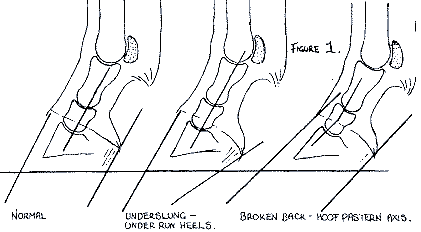
Figure 1 shows a normal hoof on the left. Note the wall, the heels and the pastern all share the same angle.
The centre drawing shows an underslung heel, where the heel grows forward at an acute angle when compared with the wall and the pastern. On the right is a broken back hoof pastern axis, where the wall and the heels share the same angle, but the pastern is more upright.
Horses with a tendency to underrun heels can be detected as weanlings and even as foals, and if they are trimmed regularly can usually perform without causing major damage.
But in some stables a large percentage of heels become underrun because the shoes are:
(1) too short in the branches (Fig 2) and;
(2) are left on for too long, encouraging the toe to grow long and the heels to grow forward.
(3) excessively turned inwards at the heels, encouraging the heels to become underrun after several shoeings (this is often done to prevent the horse from pulling the shoe off) (Fig 3).
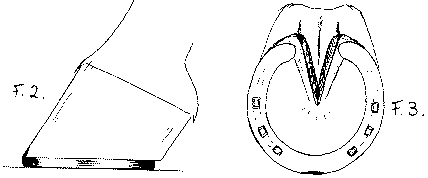
Another related condition occurs when the heel is allowed to grow too long, which weakens the wall at the heel due to it growing beyond the support of the sole.
The unsupported heel tends to grow so the heels curl under and forward. This condition is sometimes called "In Growing Heels." (Figure 4)
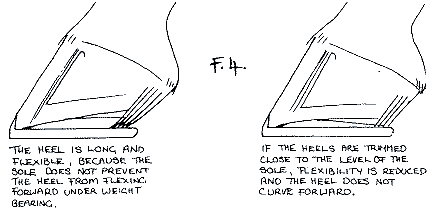
The real worry about heel problems is they are rare in wild horses and in horses that have not been shod for long periods.
This is, I believe, because of the three-point landing of the natural foot. When the foot is trimmed for shoeing, the quarter is trimmed level, and the heel tends to slide forward along the shoe at each stride.
Another reason is that as the toe grows forward, it pulls the shoe with it, and leaves the branches short at the heels.
The old truth follows - "The hoof tends to grow towards the steel," and as a result, the heel tends to grow forward with the shoe. It doesn't take many shoeings to produce full-blown Underslung Heels. See Figure 5
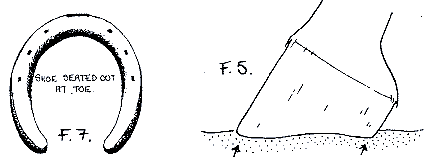
Now that we can see the causes of Underslung Heels, let's look at prevention. But, prevention of what, you might ask?
Answer: Preventing the horse from going sore as a result of Underslung Heels!
This is much easier than trying to correct the problem after damage, and weakening of the structures of the heel already exists.
Remember, when your farrier shoes a horse with Underslung Heels:
(1) the horse should be trimmed and shod every three to four weeks,
(2) the branches of the shoe should support the heel and extend back as far as practically possible. Note the bulb of the Underslung Heel usually protects the long branches of the shoe from interference.
(3) the heels should be trimmed back as far as possible toward the level of the sole. The more the heel can be trimmed, the further the posterior support can be extended. (Don't try to "stand the foot up" by leaving the heels long, and don't use wedges because they will aggravate the problem by encouraging the heel to slide forward on the shoe, See Figure 6)
(4) try to step up the shoe in the area of the quarter to assimilate the natural foot (Figure 5). This will cause a slight backwards slope at the heel helping to prevent it sliding forward along the shoe.
(5) if the heels are curling forward, cut them back until they are supported by the sole.
(6) slipper the heels of the shoe outwards and backwards (See Figure 7)
(7) When the heels are trimmed back as far as possible, the hoof pastern axis may be backwards and the heels may need to be reconstructed to bring the hoof-pastern axis towards the correct angle. Use Equilox or similar filling acrylics.
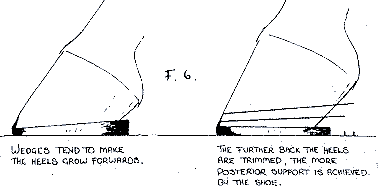
The impact of landing is centred on the heel. When the heel is Underslung, the force of impact is directed across the line of the wall, rather than up the line. (See Figure 8)
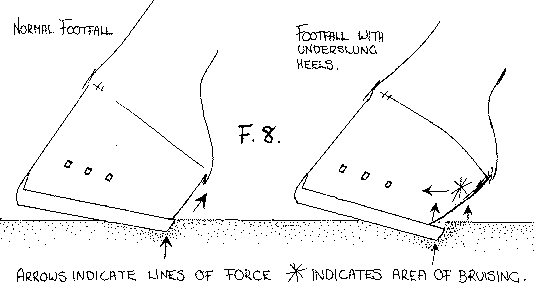
The initial bruising occurs under the wall at the heel and involves the sensitive laminae, the Lateral Cartilages and other soft tissues at the back of the heel.
Bleeding into the area can cause separation of the wall, and the space created can become a breeding place for infection.
Once the heel is separated, it may take up to four months to grow back as a healthy heel, and if continued in work may cause chronic lameness (usually bilateral). Other secondary problems may develop as a result of the change of gait which leads to a toe-first footfall.

|